Online Connect for Sage 50 Accounts
Learn how to set up and use Online connect for Sage 50 Accounts.
ReadSoft Online Connect is a program you can install on a local computer and use to perform a number of tasks, such as uploading invoices to ReadSoft Online. It is an alternative to uploading invoices using the web interface in ReadSoft Online. Using ReadSoft Online Connect, you can upload invoices automatically, lessening the effort of uploading invoices one by one.
ReadSoft Online Connect runs as a service in the background, so it is not necessary to start a program each time you want to upload invoices. Instead, you simply move the files you want to upload to the folders you specify during the installation setup.
ReadSoft Online Connect can be beneficial if you want to:
- Upload large numbers of invoices.
- Automate the process of uploading invoices.
- Download output data from Online Connect.
- Automatically register supplier invoices in external systems.
Note that the user interface for ReadSoft Online Connect is currently only available in English.
Other flavors of Online Connect
ReadSoft Online Connect can display different settings, depending on which target system you use. Before you continue reading, make sure you choose the Online Connect guide that matches your target system. If you don't find a match, read the generic guide for Online Connect.
Online Connect System requirements
ReadSoft Online Connect supports the following operating systems:
- Windows 10
- Windows 8.1
- Windows Server 2016
- Windows Server 2012 and Windows Server 2012 R2
ReadSoft Online Connect requires the following:
- Microsoft .NET Framework 4 (always required).
- An HTTPS connection which uses port 443 (always required).
The integration for Dynamics AX requires WCF Activation components.
Creating a customer account
In order to use Online Connect you must make sure that your account in ReadSoft Online is set up properly.
After you have created a new customer account, check the following:
- In order to send invoices to Sage 50 Accounts, make sure Sage 50 Accounts is specified in the target system service () for the account.
- Make sure the account does not have buyers defined. Sage 50 does not support the buyers feature in ReadSoft Online.
After you create a customer account with appropriate services, you are ready to install ReadSoft Online Connect.
Installation
To install ReadSoft Online Connect:
-
Download and run the setup file from the URL that corresponds to your location. Note that an HTTPS connection on
port 443 is required to download the installation. After the installation, the connection is required to receive program updates.
- Europe: https://production.readsoftonline.com/install/ReadSoftOnlineConnect.aspx
- Australia: https://au.readsoftonline.com/install/ReadSoftOnlineConnect.aspx
- US: https://us.readsoftonline.com/install/ReadSoftOnlineConnect.aspx
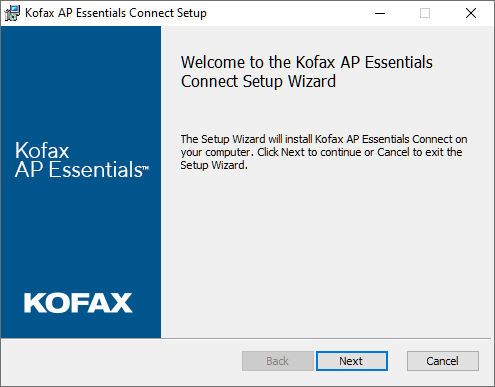
-
Specify the installation folder and click
Next to continue:
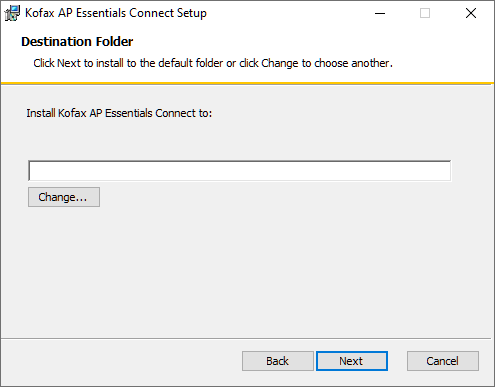
-
Click
Install to confirm your settings and install
ReadSoft Online Connect.

-
After the installation, click
Finish to launch
ReadSoft Online Connect
and run the setup wizard.

Troubleshooting the installation
When running the installation, some computers display a message that states, "Installation directory must be on a local drive." If you receive this message, run this command as an administrator in Windows Command Prompt:
msiexec /i "C:\[path]\ReadSoft.Online.Connect.Setup.msi" WIXUI_DONTVALIDATEPATH="1"
Automatic updating
ReadSoft Online Connect routinely downloads and installs updates automatically. This is required in order to ensure that ReadSoft Online Connect works properly and stays synchronized with the latest functionality and features in ReadSoft Online.
In order for automatic updating to work properly, computers running ReadSoft Online Connect must have access to the local installation folder as well as the contents of the URL that corresponds to your location:
- Europe: https://webeyeprod.blob.core.windows.net/onlineconnect/install/
- Australia: https://webeyeprodasia.blob.core.windows.net/onlineconnect/install/
- US: https://webeyeprodna.blob.core.windows.net/onlineconnect/install/
You can click the links above to test if you have access.
Online Connect Setup for Sage 50 Accounts
Be sure to specify the target-system settings correctly before you begin.
The first time you run ReadSoft Online Connect, a setup wizard appears to help you configure the initial settings. If you see the ReadSoft Online Connect dialog instead of the wizard, click Configure to display the wizard.
The steps that appear in the wizard can vary, depending on the services that are enabled in ReadSoft Online.
1. Click
Next to begin.
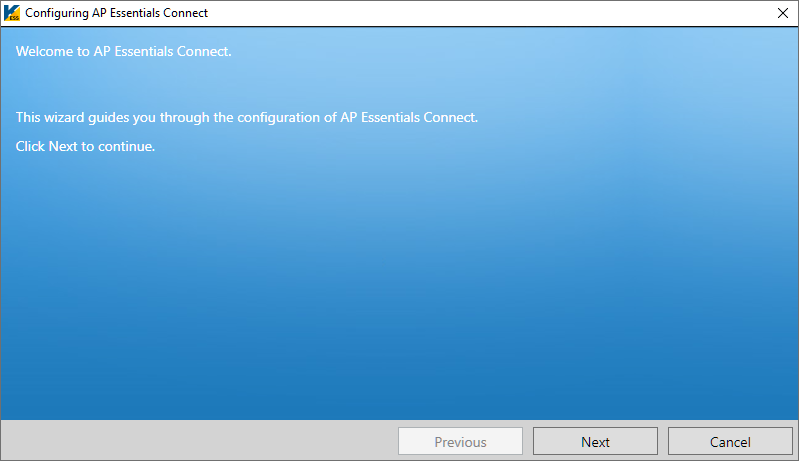
2. Use the information provided in your account-information email to fill in the Login address, Authorization key, User
name and Password.
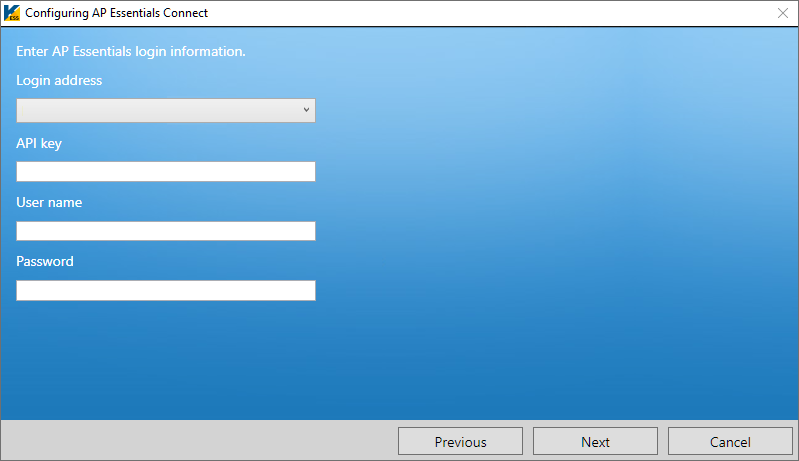
| Login address |
|
| Authorization key (API Key) | You can obtain the key from your account-information email or from an administrator, who can find the key in the Target system view in Admin Center. |
| User name | The user name you use to log in to ReadSoft Online. |
| Password | The password for User name. |
3. Configure optional dialogs that can appear, depending on the services that are enabled in ReadSoft Online:
- Configure settings for uploading documents.
- Configure settings for registering invoices in Sage 50 Accounts.
4. After you complete the required procedures from step 3 above, click
Save to save the settings and exit the wizard.
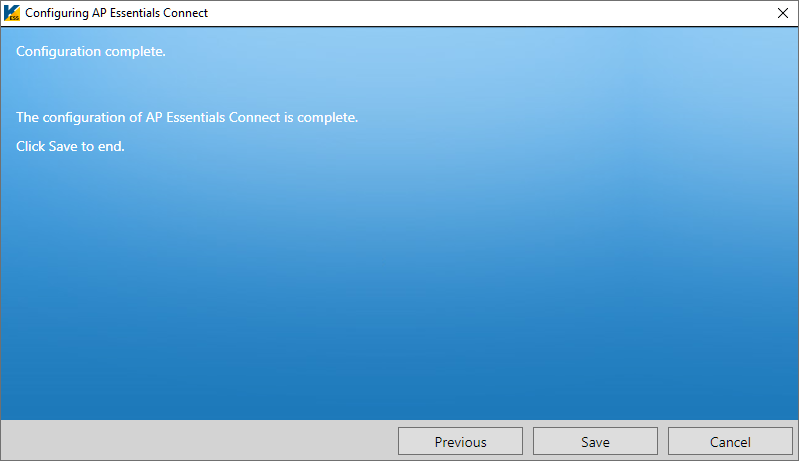
If you want to change the Output image format from TIF to PDF (Target system configuration settings), you must process all of the invoices in the system before you change this setting. Failure to do so will result in output errors.
Windows users that run ReadSoft Online Connect must have Read, Write and Modify permissions on all of the folders you specify in the setup.
Configure settings for uploading documents
If the Image upload service is enabled, you can use ReadSoft Online Connect to upload invoices to ReadSoft Online. Customers can upload their own invoices for processing, and partner administrators can upload images on behalf of all of their customers.

Ideally, you specify the Root folder, and then click
![]() to automatically generate the subfolders. Subfolder are created for each
buyer defined in
ReadSoft Online. If no buyers are defined, the subfolder
has the same name as the organization (customer). These subfolders determine which buyer the documents are connected to when they
are uploaded to
ReadSoft Online. Additional subfolders are created for
each document type, if the buyer has more than one document type.
to automatically generate the subfolders. Subfolder are created for each
buyer defined in
ReadSoft Online. If no buyers are defined, the subfolder
has the same name as the organization (customer). These subfolders determine which buyer the documents are connected to when they
are uploaded to
ReadSoft Online. Additional subfolders are created for
each document type, if the buyer has more than one document type.
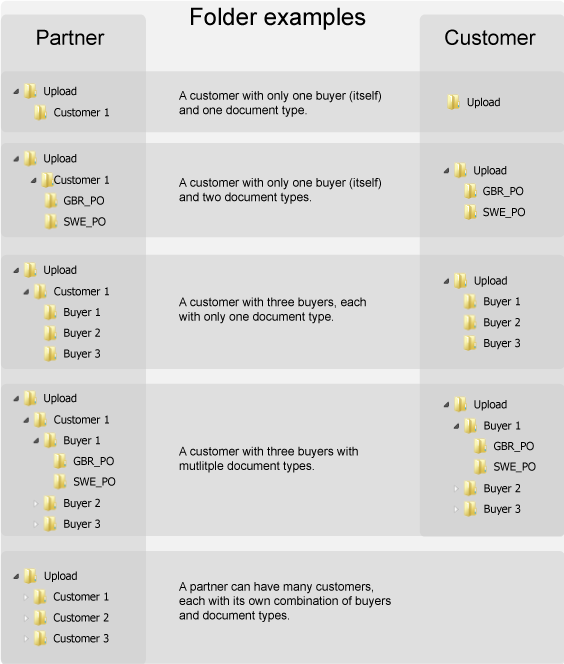

- Upload documents to ReadSoft Online – Specifies whether you use ReadSoft Online Connect to upload invoices to ReadSoft Online.
 – Auto-generates the folder structure inside the Root folder.
– Auto-generates the folder structure inside the Root folder.
 – Displays a dialog which you can use to add a folder location manually.
– Displays a dialog which you can use to add a folder location manually.
 – Displays a dialog which you can use to edit the selected folder location.
– Displays a dialog which you can use to edit the selected folder location.
 – Removes the selected folder from the Upload locations list. Note that the
folder is not deleted from the hard drive.
– Removes the selected folder from the Upload locations list. Note that the
folder is not deleted from the hard drive.
 – Removes all of the folders from the Upload locations list. Note that the
folders are not deleted from the hard drive.
– Removes all of the folders from the Upload locations list. Note that the
folders are not deleted from the hard drive.
- Upload locations – Displays a list of locations where ReadSoft Online Connect looks for images to upload to ReadSoft Online.
- Processed documents folder – Specifies the folder where you want to move the images after they have been uploaded.
- Document sorting - Determines how many documents each file can contain. See Help for more information about page separation.
- Upload documents automatically - When this setting is selected, files located in subfolders of the Folder list are automatically uploaded as soon as they are detected. If this setting is not selected, you must click the Upload documents button in the ReadSoft Online Connect interface to manually upload images.
- Allow upload of XML files with matching image file - Normally, when you upload XML invoices, ReadSoft Online automatically creates an invoice image from the XML data, so users can visualize the data during verification. If your solution uses XML invoices and an invoice image file, select this setting, so you can upload both of these files, and ReadSoft Online will display the original invoice image during verification, instead of creating one from the XML data. This is helpful because it offers the superior data capture of XML, while displaying the original invoice image, which might contain additional information that is not available in the XML. Make sure that the corresponding file pairs have the same file name.
Configure settings for registering invoices in Sage 50 Accounts
If Sage 50 Accounts is specified as your target system, you can use ReadSoft Online Connect to automatically register invoices with Sage 50 Accounts. You can also use ReadSoft Online Connect to import supplier, account currency and coding information from Sage 50 Accounts to ReadSoft Online.
See how to configure Sage 50 Accounts for use with ReadSoft Online.
-
Select
Register invoices in Sage 50 and specify the other settings.
Select Register invoices in Sage 50 and specify the other settings.
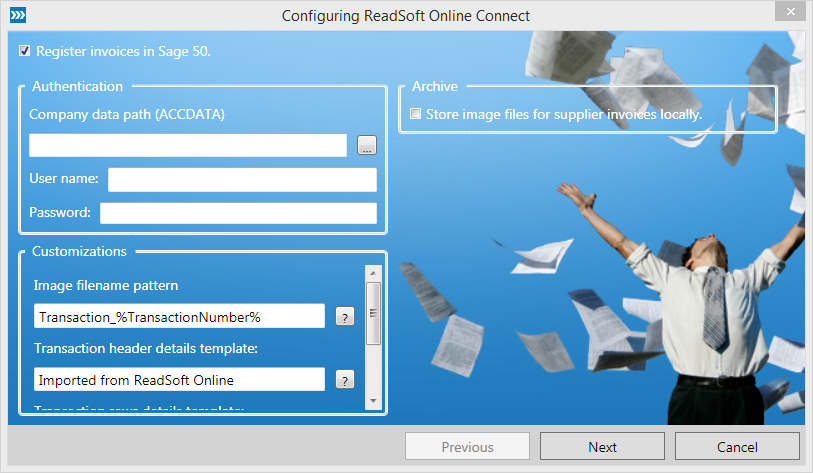
Register invoices in Sage 50 Enables the integration between ReadSoft Online and Sage 50 Accounts Authentication Company data path (ACCDATA) 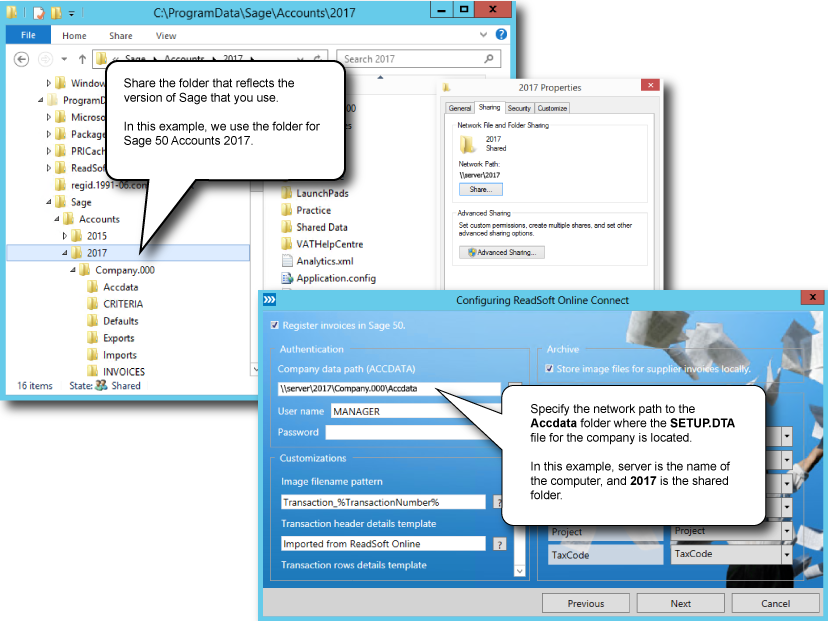
Specifies the Accdata folder where the SETUP.DTA file for the company is located.You must share the Sage Accounts version folder (example: C:\ProgramData\Sage\Accounts\2017). The folder must be a shared network folder which Online Connect can access. Note that this folder is two levels above the folder that you specify in this setting.
When specifying this setting, type the path as a network location. Example: \\some-computer\shared-folder\Company\ACCDATA\
User name The Sage 50 Accounts user you want to use to authenticate Sage 50 Accounts. Note This cannot be logged into Sage 50 Accounts at the same time Therefore, we recommend that you create a dedicated user in Sage 50 Accounts for the integration.Password The password for the Sage 50 Accounts user. Customizations Image file name pattern Specifies the image file name that is displayed on the Memo tab in Sage 50 Accounts. Transaction header details template Specifies the detail value for the document header when creating a transaction in Sage 50 Accounts. See help for information about Sage 50 data templates.
Transaction row details template Specifies the detail value for the document rows when creating a transaction in Sage 50 Accounts. Include tax codes not "In Use" The term, not in use, indicates that there is no tax. Note that this is not the same as 0% tax. If you select this setting, not in use tax codes are also uploaded to ReadSoft Online. Tip All tax codes, including not in use codes, must have a description in Sage 50 in order to be uploaded to ReadSoft Online.Enforce tax amount TaxCode When you code invoices, this setting lets you use the tax amount in the header to calculate the tax instead of using automatic calculation. To use this feature:
- Enable a tax code in Sage 50 that is not already in use, and
give it an appropriate description, such as "ReadSoft enforce VAT amount" or "Use header field tax."
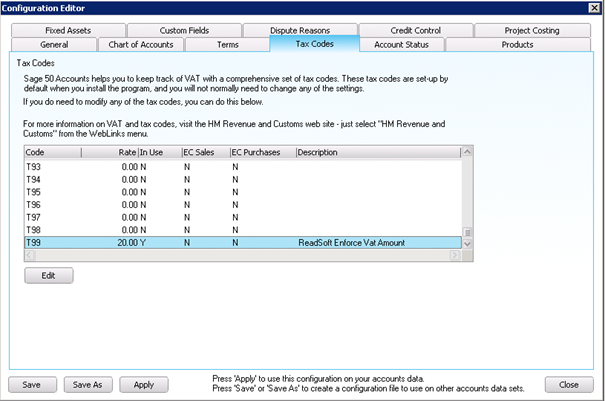
- In the
Enforce tax amount TaxCode setting in
ReadSoft Online Connect, specify the tax
code that you enabled in step one.
After you save the settings, the tax code appears in the list of other tax codes that are available during account coding. If you select this tax code, the value of the tax field in the header is used to calculate the tax instead of using the automatic calculation.

Note After you apply this tax code to a coding row, multiple coding rows are not allowed because the header tax amount cannot be split across multiple coding rows.
Coding field mapping – these settings only appear if the Workflow service is enabled in ReadSoft Online. Coding field type Specifies the internal name of a field in ReadSoft Online. Note The tax -code coding field is mandatory. You must map the “TaxCode” field in ReadSoft Online to the tax code field in Sage 50.Sage 50 field Specifies the field in Sage 50 Accounts that corresponds to Coding field type. Archive – this setting only appears if the Storage service is enabled in ReadSoft Online. If the Storage service is not enabled, imvoice images are always saved locally in Sage 50. Store image files for supplier invoices locally Determines whether invoice images are saved in subfolders in the Sage 50 application folder. The image files are saved in: ATTACHMENTS\Supplier\Supplier code
...where Supplier code is the supplier code that the invoice belongs to.
For the Image filename pattern, Transaction header details template, and Transaction row details template settings, you can use variables to specify the values. You specify dynamic values by enclosing the internal name of a document header field in percent characters (%). For the Transaction row details template setting, you can also use the internal names for line-item fields.
Examples
- %TransactionNumber% - specifies the transaction post number for the invoice.
- %InvoiceNumber% - specifies the invoice number of the current invoice.
- %LIT_ArticleIdentifier% - specifies the article identifier for a line item. Note that you can only use variables for line-item fields in the Transaction row details template setting.
- Enable a tax code in Sage 50 that is not already in use, and
give it an appropriate description, such as "ReadSoft enforce VAT amount" or "Use header field tax."
-
After you complete the configuration wizard, a dialog appears which prompts you to validate the Sage 50 Accounts
integration by providing a
Serial Number and Activation
Key. This dialog does not appear if you have already validated the integration.
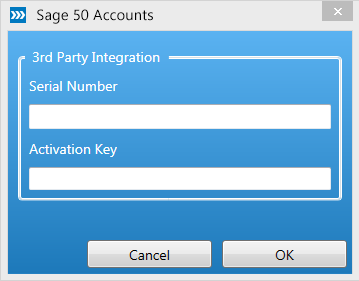
Setup for multiple customers
If you log in to ReadSoft Online Connect as a partner administrator, you can configure settings for each customer that uses Sage 50 Accounts as the target system. The feature saves you time because you do not have to log in to different accounts to configure multiple customers.
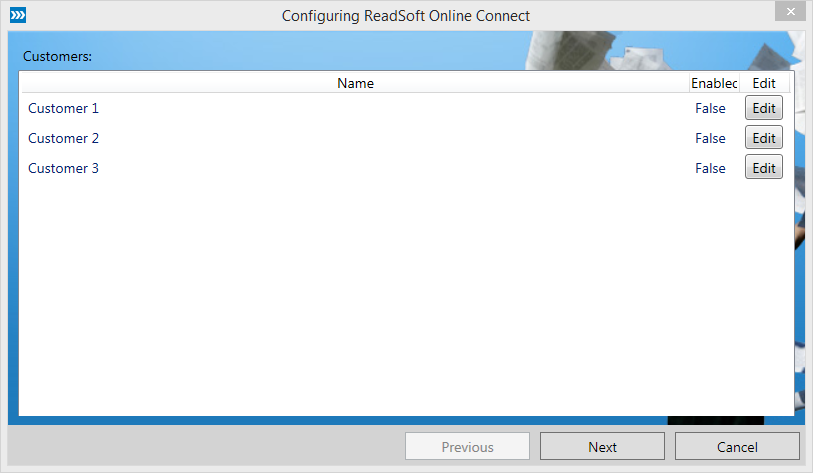
Troubleshooting the setup
If you encounter problems validating the integration:
- Open the Windows command prompt using an administrator account.
- Type “cd C:\Windows\SysWOW64” and press Enter.
-
Type “regsvr32 sgregister.dll” and press Enter. Then close the dialog and run the
ReadSoft Online
Connect setup wizard again.

Using Online Connect with PROCESS DIRECTOR AP
After following the procedures above to setup Online Connect, you are ready to use it in production.
Uploading documents using Online Connect
You can upload documents to ReadSoft Online in these supported file formats using Online Connect:
- JPEG, JPG
- PDF version 1.3 to 1.7
- PNG
- TIFF, TIF
- XML
Automatic uploading
If you selected Upload documents automatically when configuring ReadSoft Online Connect for uploading documents, no interaction is required. When files are moved to the subfolder(s) of the location you specified in the configuration, they are automatically uploaded.
ReadSoft Online Connect runs continuously in the background as a Windows service and periodically checks (every 15 minutes by default) for new files to upload. When new files are found, they are uploaded automatically. Even if you restart the computer, ReadSoft Online Connect runs automatically in the background with no need for interaction. If a problem occurs during the upload, the upload operation will timeout after 10 minutes.
Most users use automatic uploading, and set up their scanners to save files directly in the appropriate subfolders that are created during the configuration.
Manual uploading
If you did not select Upload documents automatically when configuring ReadSoft Online Connect, you can upload files manually at your convenience:
-
Start
ReadSoft Online Connect
from the Windows Start menu.

-
Move or scan invoice image files to an appropriate subfolder of the location you specified in the configuration,
and click
Refresh so you can see the files in the list. You can also click the
Event log tab to check for errors.
Note If you do not see files in the list, make sure you place the files in a subfolder that corresponds to an organization or buyer in ReadSoft Online.
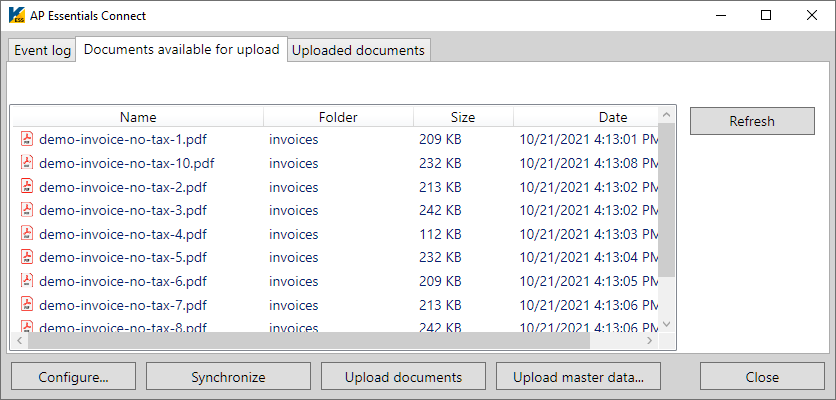
-
Click
Upload documents. You can click
Refresh to see that the images have uploaded or use the Event log to
monitor the progress of your uploads.
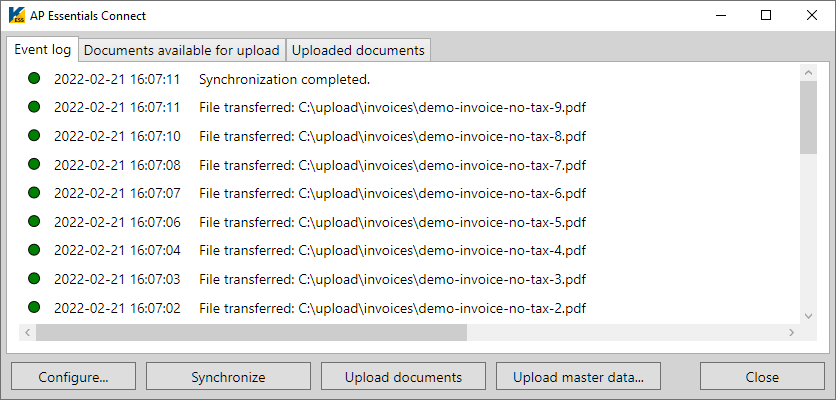
Troubleshooting Online Connect for Sage 50 Accounts
Generic issues
If you have problems running ReadSoft Online Connect:
- Make sure you have access to the URL that corresponds to your location:
You can click the links above to test if you have access. Click the links using the same computer that runs ReadSoft Online Connect. If you receive a 404 error, you do not have access.
- Make sure you can download the files that are listed in the page that is displayed when you click one of the links
above. To do this, replace
Deployment.manifest
in the URL with one of the file names in the list. - Log in to ReadSoft Online using the same computer that runs ReadSoft Online Connect to make sure you can connect to ReadSoft Online.
- If you use a proxy connection, make sure the settings are applied to the same user/account that runs ReadSoft Online Connect. By default, this is a local System account. To test this, access ReadSoft Online using a location above, then change the ReadSoft Online Connect user to the same Windows user you tested with.
Sage Data Objects Engine
You must install the Sage Data Objects Engine (SDO) on every computer that uses ReadSoft Online Connect. This engine is necessary to allow ReadSoft Online to communicate with the Sage 50 Accounts database.
The SDO is included with the Sage 50 installation, though it might not be installed by default. You can also download the SDO from the Sage developer community: https://signon.sage.co.uk/
We recommend that you use the SDO tester provided by Sage Development Services to check the SDO configuration. For your convenience, you can download the tester here.
You cannot run different versions of the SDO on the same computer. Therefore, if you use Online Connect to process invoices for multiple customers that use different versions of Sage 50 Accounts, you must use separate computers for each Sage 50 Accounts version.